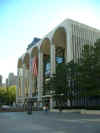 |
New York
Architecture Images-Upper West Side Lincoln Center for the Performing Arts |
|
architect |
Max
Abramovitz - Avery Fisher Hall Pietro Belluschi - The Juilliard School Gordon Bunshaft Skidmore, Owings & Merrill - The New York Public Library for the Performing Arts Wallace Harrison - Master plan & Metropolitan Opera House Philip Johnson - New York State Theater Eero Saarinen - Vivian Beaumont Theater |
|
location |
Columbus Avenue, W62 to W66 |
|
date |
1960s |
|
style |
International Style II |
|
construction |
concrete, travertine |
|
type |
Theater |
|
images |
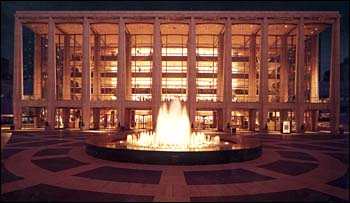 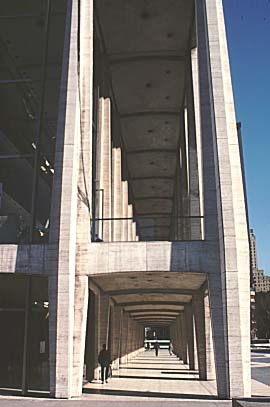 |
|
|
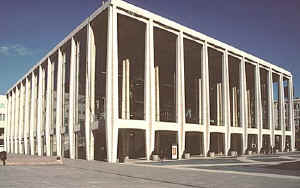 |
| Avery Fisher Hall (formerly
Philharmonic Hall), Lincoln Center for the Performing Arts Max Abramovitz 1962 Located between west 62nd to west 66th Streets and Columbus and Amsterdam Avenues, the Lincoln Center for the Performing Arts is comprised of a unity of several buildings--all of travertine--devoted to the performance of music, theater, opera, and dance. The overall project was directed by Wallace K. Harrison and completed between 1962 and 1968. The buildings surround an open, user-friendly plaza, even though the buildings are generally conservative in style. Located on the northeast corner of Lincoln Center, the former Philharmonic Hall was remodelled in 1976 by Johnson/Burgee. The lobby with clear glass is set inside a loggia with tall tapered columns of travertine. |
|
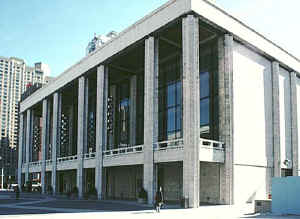 |
|
| New York State Theater, Lincoln
Center for the Performing Arts Philip Johnson 1964 Located between west 62nd to west 66th Streets and Columbus and Amsterdam Avenues, the Lincoln Center for the Performing Arts is comprised of a unity of several buildings--all of travertine--devoted to the performance of music, theater, opera, and dance. The overall project was directed by Wallace K. Harrison and completed between 1962 and 1968. The buildings surround an open, user-friendly plaza, even though the buildings are generally conservative in style. On the southeast corner of the complex, this theater, devoted largely to performances of musical thaeter and ballet, seats 2800 persons. This severely classical building has a four-story lobby. |
|
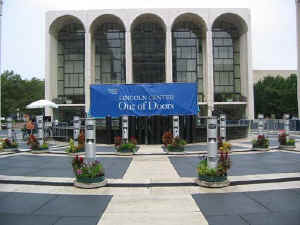 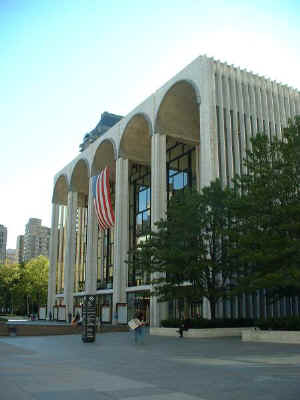 |
|
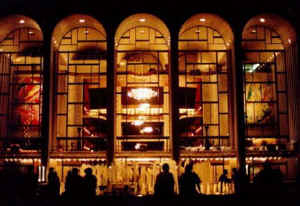 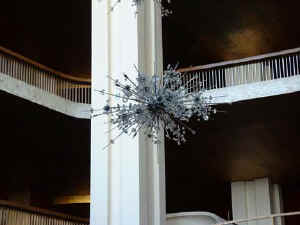 |
|
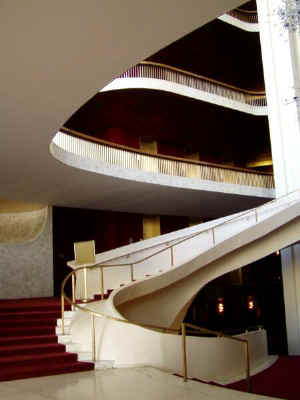 |
|
| Metropolitan Opera House,
Lincoln Center for the Performing Arts Wallace K. Harrison 1966 Located between west 62nd to west 66th Streets and Columbus and Amsterdam Avenues, the Lincoln Center for the Performing Arts is comprised of a unity of several buildings--all of travertine--devoted to the performance of music, theater, opera, and dance. The overall project was directed by Wallace K. Harrison and completed between 1962 and 1968. The buildings surround an open, user-friendly plaza, even though the buildings are generally conservative in style. The focal point of this complex, the Metropolitan Opera House, is located on the west side of Lincoln Center. It is also the largest of the buildings. The lobby has beautiful paintings by Marc Chagall as well as overwhelming chandeliers of Austrian crystal. |
|
Click here for
fascist architecture influences on Philip Johnston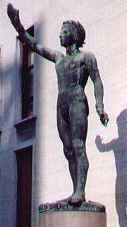 |
|
|
Lincoln Center for the Performing Arts is a 16.3-acre (61,000 m²) complex
of buildings in New York City which serves as home for 12 arts
organizations: Chamber Music Society of Lincoln Center, Film Society of
Lincoln Center, Jazz at Lincoln Center, Juilliard School, Lincoln Center
Theater, Metropolitan Opera, New York City Ballet, New York City Opera,
New York Philharmonic, New York Public Library for the Performing Arts,
School of American Ballet, and Lincoln Center for the Performing Arts,
Inc.. History and facilities A consortium of civic leaders and others led by, and under the initiative of John D. Rockefeller III, built Lincoln Center as part of the "Lincoln Square Renewal Project" during Robert Moses' program of urban renewal in the 1960s. Rockefeller was its inaugural president from 1956 and became its chairman in 1961. He is credited with raising more than half of the $184.5 million in private funds needed to build the complex, including drawing on his own funds; the Rockefeller Brothers Fund also contributed to the project.[1] The first structure to be completed and occupied as part of this renewal was the Fordham Law School of Fordham University in 1962. Located between Columbus and Amsterdam Avenues, from West 60th to West 66th Street on the Upper West Side of Manhattan, the Lincoln Center complex was the first gathering of major cultural institutions into a centralized location in a United States city. Lincoln Center cultural institutions also make use of facilities located away from the main campus. In 2004 Lincoln Center was expanded through the addition of Jazz at Lincoln Center's newly built facilities (Frederick P. Rose Hall) at the new Time Warner Center, located a few blocks to the south. In March 2006 Lincoln Center launched construction on a major redevelopment plan that will modernize, renovate, and open up the Lincoln Center campus in time for its 50th anniversary celebration in 2009. Lincoln Center for the Performing Arts, Inc. is one of the 12 resident organization listed above, and serves three primary roles: presenter of artistic programming, national leader in arts and education and community relations, and manager of the Lincoln Center campus. As a presenter of more than 400 events annually, its programs include American Songbook, Great Performers, Lincoln Center Festival, Lincoln Center Out of Doors, Midsummer Night Swing, the Mostly Mozart Festival, and the Emmy Award-winning Live From Lincoln Center. In July 2006, LCPA announced it will join with publishing company John Wiley & Sons, Inc. to publish at least 15 books, which will focus on performing arts, and will draw on Lincoln Center Institute’s educational background and archives.[2] In March 2006, and continuing through 2009, Lincoln Center launched the 65th Street Project--part of a major redevelopment plan--to create a new pedestrian promenade designed to improve accessibility and the aesthetics of that area of the campus. Diller Scofidio + Renfro are the designers in association with FX Fowle Architects. Turner Construction is the general contractor for the project. [3][4] Performance facilities Auditorium of the Metropolitan Opera House at Lincoln Center for the Performing Arts Interior of the New York State TheaterAlice Tully Hall - 1,095-seat concert hall located within the Juilliard School building; home stage of The Chamber Music Society of Lincoln Center. Currently closed for renovations; scheduled to open in winter 2008. Avery Fisher Hall – 2,738-seat symphony hall; home stage of the New York Philharmonic; formerly Philharmonic Hall The Metropolitan Opera House – 3,900-seat opera house; home stage of the Metropolitan Opera. This is the second Metropolitan Opera House; the original one opened in 1883 and was demolished in 1966, the year of the opening of the new Metropolitan Opera facilities at Lincoln Center. The New York State Theater – 2,713-seat ballet theater; originally constructed to be the home stage of the New York City Ballet, now also serves as home to the New York City Opera. Many Broadway musicals have also been revived there. Vivian Beaumont Theater – 1,080-seat Broadway-style theater operated since 1985 as the main stage of Lincoln Center Theater. Previously occupied by The Repertory Theater of Lincoln Center (1965-1973) and The New York Shakespeare Festival (1973-1977). Mitzi E. Newhouse Theater (originally known as the Forum) – intimate 299-seat theater operated by Lincoln Center Theater for its Off-Broadway-style productions The Walter Reade Theatre – 268-seat movie theater; used by the Film Society of Lincoln Center; features a raised dais used for post-screening filmmaker discussions Jazz at Lincoln Center, while a part of Lincoln Center, is located separately in the Frederick P. Rose Hall complex within the Time Warner Center at Columbus Circle. It consists of the following performance and related facilities: The Allen Room – 508-seat amphitheater with 50-foot glass wall overlooking Central Park; part of Jazz at Lincoln Center's facilities Dizzy's Club Coca-Cola – nightclub-style venue in the Jazz at Lincoln Center facility; allows jazz to be performed in its traditional venue Rose Theater – 1,094-seat concert hall designed for jazz performances. Irene Diamond Education Center – rehearsal, recording, and classroom facility at Jazz at Lincoln Center Other associated and local theatres and facilities Lincoln Center and public art: Nancy Rubins's Big Pleasure Point, August 2006Church of St. Ignatius Loyola – Roman Catholic Church located on Park Avenue between 83rd and 84th Streets on the Upper East Side; used by Lincoln Center for its great acoustics and its pipe organ (allowing expanded organ repertoire, since the Metropolitan Opera House and Alice Tully Hall are the only Lincoln Center venues with a pipe organ)[neutrality disputed] Clark Studio Theater – 120-seat dance theater; part of the facilities of the Lincoln Center Institute for the Arts in Education Damrosch Park – outdoor amphitheater with bowl-style stage known as the Guggenheim Band Shell, used for free Lincoln Center Out of Doors presentations Daniel and Joanna S. Rose Rehearsal Studio – rehearsal studio of The Chamber Music Society of Lincoln Center The Gerald W. Lynch Theater at John Jay College – theater at John Jay College of Criminal Justice; used for the Lincoln Center Festival and Great Performers series Josie Robertson Plaza – central plaza of Lincoln Center featuring its iconic fountain; the three main buildings (Metropolitan Opera House, Avery Fisher Hall, and New York State Theater) face onto this plaza; used as an outdoor venue during Midsummer Night Swing and Lincoln Center Out of Doors presentations Juilliard School – facility housing the school of the same name; building also incorporates Alice Tully Hall, Morse Recital Hall, Paul Recital Hall, the Juilliard Drama Theater, and the Peter J. Sharp Theater]] Peter J. Sharp Theater Morse Recital Hall – recital hall within the Juilliard School New York Public Library for the Performing Arts Paul Recital Hall – recital hall within the Juilliard School Pope Auditorium - theater located in Leon Lowenstein Hall of Fordham University's Lincoln Center campus (located across West 62nd Street from Lincoln Center) Stanley H. Kaplan Penthouse – nightclub-style venue; used for intimate concerts, “Meet the Artist” and Great Performers events, lectures, and other events where a small, intimate space is preferred; was also used for jazz performances prior to the construction of the new Jazz at Lincoln Center facilities Resident Organizations Lincoln Center houses several cultural companies and institutions, including: American Ballet Theatre The Chamber Music Society of Lincoln Center Film Society of Lincoln Center (sponsor of the New York Film Festival) Jazz at Lincoln Center The Juilliard School Lincoln Center for the Performing Arts, Inc., also called "Lincoln Center Presents" Lincoln Center Theater Metropolitan Opera New York City Ballet New York City Opera New York Philharmonic New York Public Library for the Performing Arts School of American Ballet Architects Architects who designed buildings at Lincoln Center include: Max Abramovitz - Avery Fisher Hall Pietro Belluschi - The Juilliard School (including Alice Tully Hall) Gordon Bunshaft - The New York Public Library for the Performing Arts Wallace Harrison - Master plan & Metropolitan Opera House Philip Johnson - New York State Theater Eero Saarinen - Vivian Beaumont Theater Historical events April 21, 1955 - Lincoln Square designated for urban renewal. June 22, 1956 - Lincoln Center for the Performing Arts, Inc. incorporated. May 14, 1959 - Ground breaking ceremony with President Dwight D. Eisenhower. September 23, 1962 - Philharmonic Hall (now Avery Fisher Hall) opened. April 6, 1964 - Lincoln Center Fountain opened. April 23, 1964 - New York State Theater opened. October 14, 1965 - Vivian Beaumont Theater and the Forum (now Mitzi E. Newhouse Theater) opened. November 30, 1965 - The Library & Museum of the Performing Arts opened. September 16, 1966 - The Metropolitan Opera House opened. May 22, 1969 - Damrosch Park and the Guggenheim Band Shell opened. September 11, 1969 - Alice Tully Hall opened. October 26, 1969 - Juilliard School opened. October 19, 1976 - Avery Fisher Hall re-opened after renovation to improve acoustics. December 4, 1981 - The Big Apple Circus performed at its winter home in Damrosch Park for the first time. The circus has performed every winter at Lincoln Center ever since. September 7, 1982 - New York State Theater re-opened after renovation to improve acoustics. September 2, 1986 - Former Jewish Defense League National Chairman Victor Vancier throws a tear gas grenade during a performance of Soviet ballet in the Metropolitan Opera House as a protest against the Soviet practice of not letting its Jews emigrate to Israel. November 19, 1990 - The Samuel B. and David Rose Building opened; houses the Walter Reade Theater, the Stanley H. Kaplan Penthouse, the Daniel and Joanna S. Rose Rehearsal Studio, the Clark Studio Theater, and Juilliard School student residences, as well as office space for a number of the member organizations. December 3, 1991 - The Walter Reade Theater opened within the previously completed Samuel B. and David Rose Building. July 12, 1997 - The Paul Milstein Plaza dedicated. October 18, 2004 - Jazz at Lincoln Center opened. March 2006 - Preliminary construction on the West 65th Street Project begins June 8, 2006 - Plans for Lincoln Center to transform the nearby Harmony Atrium into a public space for the arts open to the public, neighbors, students, and Lincoln Center patrons are announced. June 12, 2006 - The Lincoln Center Promenade initiative to revitalize Lincoln Center's Columbus Avenue frontage and the iconic Josie Robertson Plaza is unveiled. August 20, 2006 - Paul Milstein Plaza dismantled as part of 65th Street Redevelopment project. In popular culture In popular culture, in the 1990s PBS game show Where in the World Is Carmen Sandiego? Robocrook stole the Lincoln Center. |
|
|
Lincoln Center for the Performing Arts is a
15-acre complex of buildings in New York which serves as home for 12
arts companies. It was built during Robert Moses's program of urban
renewal in the 1960s. It was the first gathering of major cultural
institutions into a centralized location in an American city, and was
located between Broadway and Amsterdam Avenues, between 62nd and 66th
Streets. The facilities include the Metropolitan Opera House, New York State Theater, Avery Fisher Hall, Alice Tully Hall, Damrosch Park, Vivian Beaumont Theater, Mitzi E. Newhouse Theater, The Juilliard School, The Walter Reade Theatre, and the New York Public Library for the Performing Arts. Some of these have changed their names: Mitzi E. Newhouse Theatre was previously named The Forum, and Avery Fisher Hall was previously Philharmonic Hall. Some of the plazas have acquired names commemorating charitable contributions (Paul Milstein Plaza, Julian Robertson Plaza). Lincoln Center houses several cultural companies and institutions, including: The Chamber Music Society of Lincoln Center The Film Society of Lincoln Center (sponsor of the New York Film Festival) Jazz at Lincoln Center The Juilliard School Lincoln Center for the Performing Arts, Inc., also called "Lincoln Center Presents" Lincoln Center Theater Metropolitan Opera New York City Ballet New York City Opera New York Philharmonic (directed by Lorin Maazel) The New York Public Library for the Performing Arts School of American Ballet |
|
|
Urbanities Manhattan's Own Piece of Classical Vienna By Veronica Zaragovia Columbia Daily Spectator April 06, 2004 Gold-colored walls, velvet chairs, crystal chandeliers, and balconies. No, this is not the interior of a celebrity home on MTV's Cribs, but the splendid auditorium of the historic Metropolitan Opera, boasting the largest stage in the Lincoln Center complex. To many, the Met is the quintessential New York structure, with a large, white, spiraled staircase in the lobby where affluent New Yorkers come to hear some of the nation's most legendary opera.The real Metropolitan Opera, however, defies all presumptions. Here, days and nights are filled with grueling backstage work, tours, preparations, rehearsals, heart-wrenching performances, and audience members of all ages and wallet-sizes. Although the Met has been around since the early 1880s, most Columbia students only think to get their opera fix on Friday nights at Café Taci. For a relatively low price of $25, however, students can sit approximately seven rows from the stage, and for an additional five dollars, they can take a backstage tour that reveals everything from the wig department to the hallway where Madame Butterfly's kimonos are hung. Originally, the opera house stood at 1423 Broadway, between 39th and 40th Streets. In 1966, it moved up 20 blocks to where it presently stands at 66th Street, reopening on Sept. 16 of that year. Ed Hanin, a member of the Metropolitan Guild who led the tour of the opera house, explained that "because the old building had such a small storage space, sets for an opera had to wait outside, even in winter weather, until it was time to bring them in. Today, however, sets for multiple operas can fit at the same time within the vast storage spaces of the building." The ritzy neighborhood that houses the Met was not always the Lincoln Center of today. The area was a violence-ridden "scene from West Side Story, with tension between the Irish and Puerto Rican immigrants, but now this is one of the highest rental districts of Manhattan," Hanin said. Even on weekday nights, a large audience fills the auditorium, whose crystal chandeliers were a gift of the Austrian government out of gratitude to the United States for helping to restore Vienna's State Opera House after its destruction in World War II. According to Hanin, about 60 percent of the Metropolitan Opera's revenue comes from ticket sales, and only about 0.3 percent comes from government grants. This season, the operating budget for the Met is $200 million. The auditorium can seat 3,800 people, and 195 can fit in the standing room spaces. At a Tuesday night performance of Madame Butterfly, a younger, slightly less pompous crowd filled these seats. As everyone gathered in the lobby during the intermission, Rob Travieso, a Masters student at Brooklyn College clad in jeans and Converse sneakers, said he was "impressed with the beauty of the set" and glad that the opera's plot was progressing at a reasonable pace. In 2002, he attended a performance of War and Peace, which kept him crossing his legs in perpetuity as he waited for the "extraordinarily long" opera to finish. Yohay Lev-Ram, another trendy and casually dressed member of the audience, said he was "[enjoying] the personal subtitles attached to every seat" because they "enhance the drama of the plot." He was also "impressed with the Marc Chagall paintings that hang over the bar and the restaurant." During the intermission, most of the audience left their seats to gather in the lobby, socialize, and spend inordinate amounts of money. A small cappuccino cost five dollars, while an Evian bottle of water sold for four. One of the restroom custodians, who preferred not to give her name, explained that despite her hunger, "there's really nothing I can eat [here]. I'm on the Atkins diet, and all they sell are sandwiches and brownies." Although the opera performance is certainly unforgettable, the backstage tour is yet another unique opportunity. Backstage, "212" refers not to the café, but rather to the location of the wig department. Tom Watson, the director of the Metropolitan Opera's wig department, was working on the custom-made wigs from "human or yak hair" when we visited. In addition to overseeing the day to day running of the Met's wig department, Watson will also work on the wigs for both Wicked and Assassins on Broadway. He said he has been making wigs for the Met and other opera houses all over the country since 1979; each wig takes 30 to 40 hours to complete. In fact, every detail of the Metropolitan Opera House has been tweaked to near-perfection. In the auditorium, the walls surrounding the wide stage undulate to prevent sound from getting trapped in angles, and carpeting is purposely omitted to enhance the acoustics. "The sound is not amplified, so what you hear is the real thing," Hanin said. It's true that the opera is an acquired taste, since performances last an average of three hours. Without knowing the basic plot, an audience member can become lost, since the majority of operas were written in Italian, French, and German. But Columbia students willing to pay $25 for a rush ticket will likely agree that it's well worth waiting for the opera to end, and the fat lady to sing. |
|
|
links |
www.lincolncenter.org |